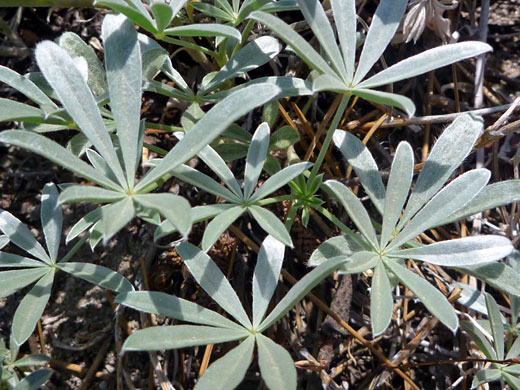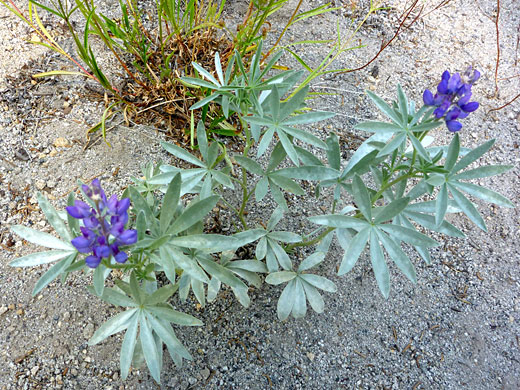Common names:
Satin lupine, bluntlobe lupine
Family:
Scientific name:
Lupinus obtusilobus
Main flower color:
Range:
North California and far west Nevada
Height:
Up to 1 foot
Habitat:
Gravelly, open places; up to 11,400 feet
Leaves:
Divided into 6 or 7 leaflets, each between 1 and 2 inches long
Season:
June to September
Lupinus obtusilobus is a small species, with stems up to one foot tall, growing upwards or sideways. Leaves and stems have a covering of silvery, silky hairs, pressed against the surface. The number of leaflets is less variable than for many other lupines, either six or seven. The inflorescence is a compact cluster occupying the upper few inches of the stem.
Flowers (around half an inch long) are arranged in whorls, and attached to the stem by short, bracted pedicels. The upper calyx lip is two-lobed, and the lower is three-lobed. Petals are colored blue to purple, with a white or pale yellow banner spot. The back of the banner petal is hairy, as is the upper margin of the keel petal; the lower margin is ciliate. Plants are found in the mountains of northern California, extending to the Lake Tahoe area in west Nevada.
Flowers (around half an inch long) are arranged in whorls, and attached to the stem by short, bracted pedicels. The upper calyx lip is two-lobed, and the lower is three-lobed. Petals are colored blue to purple, with a white or pale yellow banner spot. The back of the banner petal is hairy, as is the upper margin of the keel petal; the lower margin is ciliate. Plants are found in the mountains of northern California, extending to the Lake Tahoe area in west Nevada.
All Contents © Copyright The American Southwest | Comments and Questions | Contribute | Site Map




